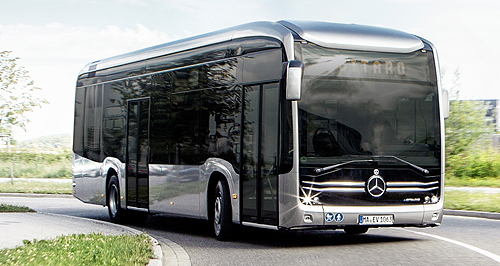Make / Model Search
Future models - Mercedes-Benz - Citaro - eMercedes unveils electric Citaro busGreen machine: The Mercedes-Benz eCitaro has been revealed ahead of a debut at a commercial vehicle motor show in Hannover in September. New Mercedes-Benz eCitaro revealed ahead of 2018 debut, Aus future unclearGallery Click to see larger images 12 Jul 2018 MERCEDES-BENZ has uncovered its all-electric eCitaro passenger bus set to launch in Europe later this year, however an Australian debut remains in doubt due to the EV being produced in left-hand drive only.
Daimler Truck and Bus Australia head of public relations James Stanford told GoAuto that if the eCitaro were to made in right-hand drive, the company would look at the business case to bring it Down Under.
Based on the same chassis as the internal-combustion Citaro, the eCitaro uses a pair of electric portal axles with motors at the wheel hubs, each producing 125kW/485Nm.
Power is delivered from between six and ten 25kWh battery modules producing a combined capacity of up to 243kWh. The modules are spread around the bus, including two on the roof and four in the rear. Four additional modules can be added on the roof if necessary.
Mercedes claims that the eCitaro can achieve a driving range of up 250km, with mid-summer “worst-case scenario” conditions still delivering 150km of range. The batteries can maintain ideal operating temperature thanks to a roof-mounted cooler system that can also be supplemented by the climate control.
Up to 88 passengers will be able to ride the bus, depending on the number of battery modules specified as a full set of batteries weighs 2.5 tonnes.
Plug-in charging will be standard, but Benz is also developing an opportunity charging solution involving a roof-mounted tram-style pantograph above the front axle, which will be gradually phased in once series production begins. Charging times have not been detailed.
The eCitaro gains slightly differentiated styling from the Citaro inspired by the Future Bus concept that, according to Mercedes, displays “clearly drawn contours and no showmanship whatsoever”. All sight-lines and mirrors are the same as the Citaro to help drivers transition into the new model.
Interior design is updated with a new roof that hides the heating, ventilation and air conditioning (HVAC) vents, and integrates the LED lighting and loudspeakers, while black sills and window pillars are also new.
The driver’s cockpit is largely unchanged except for the instrumentation, with a power meter replacing the tachometer, and information regarding the range, available power and charging indicator able to be accessed.
Interior design will eventually roll out to the rest of the Citaro range.
To deal with the battery-taxing nature of heating and air-conditioning, Mercedes engineers have cut required energy for the HVAC controls by 40 per cent by using “innovative components” that have been developed in time for the eCitaro’s launch.
A heat pump is used to warm the passenger compartment, while a fuel-powered auxiliary heater can be optioned for use in extreme weather conditions.
The eCitaro will make its public debut at the IAA Commercial Vehicles show in Hannover in September, before the first customer deliveries commence before the end of the year. 20 examples have already been ordered by a Hamburg transportation company.  Read more19th of October 2017  Tokyo show: Toyota reveals two fuel-cell concepts310kW six-seater car and near-production bus fuel-cell concepts unveiled by ToyotaAll future modelsMotor industry news |
Click to shareMercedes-Benz modelsResearch Mercedes-Benz All future modelsMotor industry news |


















 Alfa Romeo
Alfa Romeo Abarth
Abarth Audi
Audi Aston Martin
Aston Martin BMW
BMW Bentley
Bentley Ferrari
Ferrari Chevrolet
Chevrolet Ford
Ford Fiat
Fiat GWM
GWM Foton
Foton Hyundai
Hyundai Honda
Honda Jaguar
Jaguar Isuzu
Isuzu Kia
Kia Jeep
Jeep Land Rover
Land Rover Lamborghini
Lamborghini Maserati
Maserati Lexus
Lexus McLaren
McLaren Mazda
Mazda Mercedes-Benz
Mercedes-Benz Mitsubishi
Mitsubishi Mini
Mini Peugeot
Peugeot Nissan
Nissan Ram
Ram Porsche
Porsche Rolls-Royce
Rolls-Royce Smart
Smart Skoda
Skoda Suzuki
Suzuki Subaru
Subaru Toyota
Toyota Tesla
Tesla Volvo
Volvo Zeekr
Zeekr







Facebook Twitter Instagram